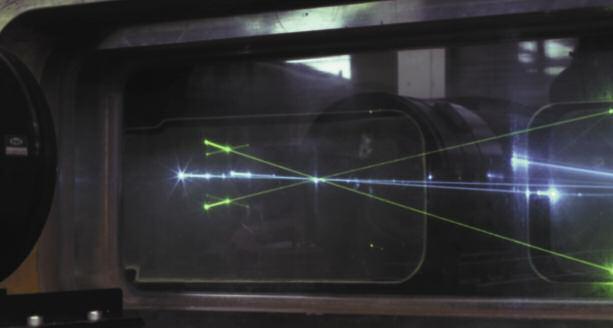
15 minute read
Submarine Force Technology: Building a better way of life for the future
(top) The Applied Research Laboratory's Garfield Thomas Water Tunnel at Penn State has helped in the development of advanced instrumentation such as laser measurement systems.
(bottom) The tunnel, dedicated in 1949, was so large the building that houses it on campus was constructed around it. According to Penn State, the idea behind the tunnel was to provide a unique hydrodynamic facility to study cavitation phenomena in designing wake-adapted propellers that have led to quieter Navy propulsors. The tunnel has also been used to calibrate model-installed acoustic pressure and unsteady force transducers.
Advertisement
Equipped with the most advanced weaponry and surveillance capabilities in the history of naval warfare, the Submarine Force patrols the world’s oceans to defend our nation and preserve the American way of life. But the same technical advances now propelling the undersea force into the future may also have significant potential for making that way of life even better for us all.
Investments in military technology have often spilled over into everyday life to benefit all Americans. For example, the Internet grew from the desire of the Defense Advanced Research Projects Agency (DARPA) to design a network for allowing computers at different universities to communicate with each other without a central control node. As a result of the adaptation of this military technology for everyday use, today’s wired world shares information at speeds unimagined only a few decades ago.
On the other hand, not every military development transferred to civilian use has been high technology. In World War II, a product called “duck tape” was used for water-proofing ammunition cases. Soldiers also found it useful for repairing jeeps, guns, and even aircraft, and the tape went on to commercial fame as “duct tape,” for sealing seams in air ducting and an infinite variety of other household tasks.
Thanks to the know-how of a number of scientists who have spent their professional lives on advancing submarine technology, a number of other improvements in the quality of civilian life may be close to realization right now.
One place where this work is underway today is a nondescript group of buildings on a leafy campus in a rural valley of Pennsylvania. Some of these promising new technologies are still in the minds of scientists strolling the halls or sketched on a drawing board or computer screen. Others are tinkered with in the noisy laboratories inside. And a few are already in the fleet, under test by Submariners who will soon be using them in the near future. Unexpectedly, a handful of these new ideas may eventually be adapted for home use in cooling ice cream or building a quieter lawnmower.
During World War II, the Navy mobilized scientists and engineers from universities nationwide to join the war effort, and one group was located at Harvard’s Underwater Sound Laboratory. These acoustics experts made major advances in wartime sonar systems for detecting German U-boats and acoustically-guided homing torpedoes to sink them.
With the end of the conflict, many of the organizations that were mobilized for the war effort returned to their civilian work. The Navy, however, was determined to continue
S U B M A R I N E F O R C E T E C H N O L O G Y:
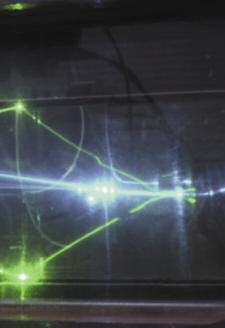
Building a better way of life for the future
its wartime joint ventures with Harvard and other universities. When the director of the Harvard research team, Dr. Eric Walker, left for a position at Pennsylvania State University, the Navy asked him to continue his undersea warfare research on its behalf, a partnership that continues to this day at Penn State’s Applied Research Laboratory (ARL).
“We work with the submarine program in developing a range of technologies to meet the needs of the fleet, especially research on propulsor noise and new types of propulsors and propulsion systems,” said Dr. Edward Liszka, ARL’s director. “This is a technology-focused lab – that’s our product. We believe you have to get out there and demonstrate new ideas, establish credible performance, and address issues that often prevent implementation of new technology in the fleet. Our goal is to get the technology out there and get people to use it. In that kind of development and testing, we often find issues that are fixable in the next technology upgrade.”
Other universities across the country, such as Johns Hopkins and MIT, join Penn State in supporting the Navy by employing some of the nation’s finest scientific talent to maintain the Submarine Force on the cusp of the possible. In these efforts, Navyfunded scientists use ARL equipment such as the Garfield Thomas Water Tunnel, the most active closed-loop test facility in the world, which serves a purpose similar to that of an aeronautical wind tunnel in studying hydrodynamics and hydroacoustics problems. This 48-inch diameter tunnel is so large that at the time of its construction in 1949, the building it is housed in had to be constructed around it. When operating at a velocity of 35 knots, more than a million gallons of water shoots through the test section every three minutes.
“We’re looking to get the most out of the things we do, Dr. Liszka said. “The underlying science and physics we develop from submarine research often give us the opportunity to do things differently in other fields.”
One such example is using ideas from submarine technology to build a better lawnmower.
Talk to ARL’s Dr. Courtney Burroughs for a few minutes, and he will explain that the blades under a power mower are similar to those of a ship’s propeller. His work to build quieter submarines gave him an idea. “The propeller blade under the deck of the mower is the thing that makes most of the noise. But a lawn mower works in a much more hostile environment than the ocean,” he said. Nevertheless, his team applied to lawnmowers some of the same techniques they would use to study a noisy propeller. “We put sensors on the blades to look for unsteady pressure and impedance discontinuities,” Dr. Burroughs explained. Understanding these phenomena led to a contract to develop a quieter mower.
Moreover, if lawnmower blades are analogous to a ship’s propellers, then so are other fans – ranging from the ones used to scrub dust out of the air in a coal mine to those employed in a breathing machine to help people suffering from sleep apnea. But Dr. Burroughs was not satisfied with constructing a quieter fan for bedroom and coal-mine use. Using sensor data on unsteady pressure and broadband noise that he gathered from testing propellers in the ARL Water Tunnel, he discovered another use for his findings.
“Auto tires,” he said. “There’s a fairly violent reaction where the rubber meets the road.” So, by embedding sensors inside some steel-belted radials and measuring the impacts of the underlying asphalt as if it were water rushing past the edges of a propeller blade, the same science used in reducing the noise of submarine propulsion could lead to a quieter ride on the highway.
Research into building a better submarine has also pushed the state of the art in metallurgy and provided stronger gears, which operate at lower temperatures,
Dr. Arnie Fontaine demonstrates a model of an artificial heart valve. Through the study of cavitation effects and the measurements of the velocity of blood through a valve, ARL has advised manufacturers on how to avoid the lifethreatening problem of blood clots in totallyimplantable artificial hearts.
reduce contact and bending fatigue, diminish metal debris and wear, and minimize noise and vibration. Instead of grinding a hardened blank to finish the teeth of a gear, a new technique – called ausforming – uses an induction-heating process to heat the surface layers of gear teeth to over 1,700 degrees Fahrenheit to make them malleable for further finishing operations. “After this surface-layer heating, we submerge the gear in hot oil at about 500 degrees Fahrenheit and form-finish the teeth by rolling them against precision dies to highly-specific tolerance levels,” said engineer Nagash Sonti. Sonti added that not only is ausforming much faster than grinding, it also makes the metal harder and stronger than conventional heat treatment. He also noted that this technology could hold significant promise for the auto industry. “Ausforming could reduce gear manufacturing costs by a third – yet you still could have the same gear strength. It is just too expensive to grind gears for cars, but with ausforming, we can make a gear with high tolerance, higher surface strength, and better specifications at a much cheaper cost.”
As one result of another material-science breakthrough, ARL engineer Ken Meinert expects that submariners throughout the fleet will soon be walking all over his work. Laser Beam Welded Corrugated Core (LASCOR) sandwich panels are designed to reduce the weight of a ship’s decks, bulkheads, and hatches without sacrificing strength and durability. In much the same way that a corrugated cardboard box develops its strength, panels of sheet metal spotwelded to a corrugated core show great promise for ample strength and stiffness with low weight. But the spot welding process is specialized and costly. Moreover, traditional arc welding tends to distort the shape of the panels. Using lasers, however, the necessary welding can be employed continuously to make a durable bond between the cladding and the corrugated core. “You can vary its strength, make the sheet wide or narrow, make the sheets as thick as you want – all making the product much stronger than a thin sheet itself,” Meinert said. “With the same strength, it’s
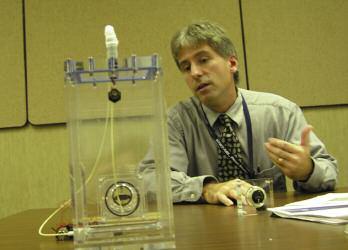
considerably lighter than thicker sheet metal and eminently engineerable.”
LASCOR material has been used for one of the radar platforms on USS Mount Whitney (LCC-20) since 1994, and data is being collected on that assembly to determine if the approach can be used to replace conventional materials in other applications for both surface ships and submarines.
Other submarine metallurgy investigations have even led to better sewage treatment!
“We used a physics-based analytical approach to problem solving when someone came to us and said, ‘I have a problem with my bioreactor,’” said Dr. Victor Fishman, the head of the Industrial Support Office at the ARL. “We often see problems that require our scientists and engineers to make the leap from submarine technology to viable solutions in other areas – in this case, a better way to treat raw sewage.”
A revolutionary new sewage-treatment plant design uses a rotating latticework drum to aerate the incoming sewage, thus ensuring the viability of bacteria that are used to break down the material. These bacteria convert raw, putrid sewage on one side to pure, drinkable water on the other. According to Dr. Greg Dillon, the structural design of this composite bioreactor and the selection of processes and materials for fabrication of its central shaft, netting, and interior pultrusions “incorporate advances that resulted from work we did for the Navy. Our experience on submarine programs definitely helped in finding the right filaments and processes for the drum to make this work.”
Another leap from submarine technology to commercial use is the idea of using sound energy for refrigeration. The basic physics behind the phenomenon is simple –as a gas expands, it gets cooler; as a gas is compressed, it heats up. Since sound waves cause a gas to rapidly expand and contract, temperature fluctuations in the gas can cause heat to move between a surface and the gas. Furthermore, if the gas motion and temperature fluctuations are phased properly, the transfer of heat can be used as a refrigerator.
But there are challenges involved with trying to harness sound waves for this purpose. “There’s not much energy available in ordinary sound at conversational levels,” said Bob Smith, an engineer at the ARL who works with program lead Steve Garrett, “so we’ve built very powerful and efficient loudspeakers to create really loud sounds and instead of air we use a pressurized inert gas to propagate the sound waves.” At the laboratory, a prototype of this cooling device is only a foot and a half tall and ten inches in diameter. The motor, a 200-watt loudspeaker, plays into one end of the cylinder, blasting out a note equivalent to a low G on the piano, at a level of nearly 200 decibels. A recent breakthrough in the implementation of the concept has enabled the lab to build an ice cream freezer that is 85 percent efficient. By contrast, ice cream freezers in common use today are about 70 percent efficient.
The possibilities for this technology are mind-boggling. Imagine a machine that “provides refrigeration without sliding seals, without concern for machinery tolerances, without concern for dust and dirt, and which doesn’t harm the environment,” said research associate Matt Poese. And paradoxically, for a device that generates 200 decibels internally, it gives off only a soft, low hum when operating. Further, the
(above) ARL engineer Ken Meinert peers through a sample of LASCOR, a laser-welded corrugated sheet metal that could be used as lighter, durable deckplating.
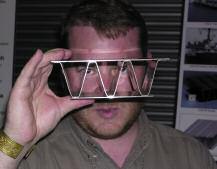
(below) Engineer Nagash Sonti checks a machine gear wheel constructed through Ausforming, a process that uses induction heating to permit form-finishing the teeth to extremely high tolerance levels.
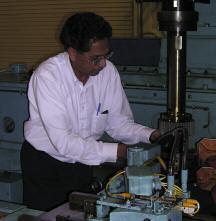
small size of this sound-powered cooling module permits placement anywhere in a submarine, thus improving the efficiency and reliability of the ship’s refrigeration systems. “We didn’t start out to solve an environmental problem,” Poese said, referring to the lack of harmful chemicals in the machine. “But something like this was only possible because we have an intimate knowledge of acoustics.”
That knowledge of acoustics was key to devising a new force-protection multiplier. By suspending a wire in a chain-link fence so that it can detect minute movements, scientists proved it was possible to turn a stretch of fence into a sensor itself. With special processing, the vibrations generated in the fence can localize a disturbance to within 30 to 50 feet, thus allowing the sensor to direct a remote camera toward potential infiltrators.
“The algorithm we developed localizes the source of the vibrations, so anyone can set up a system of their own,” said Dr. Nick Nicholas, one of the developers of the sensor fence along with Dr. Dave Swanson. Soon, multiple, embedded wires, processed in much the same manner as the elements of a towed sensor array, could eliminate the need for large numbers of Sailors – or other security forces – to patrol long stretches of a perimeter.
Submarine technology is also being applied to the solution of health problems, notably in the field of artificial heart design. Studying the phenomenon of cavitation has produced a cadre of ARL experts regularly consulted by the cardiology community ever since the lab helped build a left-ventricular assist device some three decades ago. Today, the scientists at Penn State use knowledge gathered from submarine acoustics research to study potential damage to blood cells when prosthetic heart valves open and close in an artificial heart. “Our work on propeller blades over the past 30 or 40 years has helped us to develop the techniques that are standard in cavitation research today,” said Dr. Arnie Fontaine.
To help solve the problem of blood damage, ARL scientists have used a high-resolution camera to “freeze a region in space” during each phase of the opening and closing of the artificial valve. This data is used in assessing the viability of occluder materials and designs in reducing cavitation damage and to make recommendations to artificial-heart manufacturers for improving their products. A side benefit of this particular study is better understanding of the life-threatening problem of thrombus – the formation of a blood clot on a surface or freely floating in the blood – in totallyimplantable artificial hearts. It turns out that the velocity of the blood, measured with instruments not unlike those used on a grander scale in the Water Tunnel, has a correlation to thrombus development and that the resulting data can be used to study their formation.
Modern emergency medicine has also benefited from the development of algorithms devised to allow communication among widely-distributed shipboard systems. Janet Johnson worked with her colleagues at ARL to address a similar communication problem among paramedics, fire fighters, and doctors in hospital emergency rooms by writing software for a Palm Pilot. As Johnson noted, “A lot of the information they get is verbal, told to first responders and passed through a nurse before it reaches the doctor. So the doctor is starting from scratch in some cases on what to do for a patient.” The software provides an electronic means to transmit information to an ER doctor using touch screens, drop-down menus, and algorithms that allow a quick interface with a desktop computer. In addition to helping to make crucial, life-saving decisions in the field and the emergency room, the software has a collateral benefit. First responders now have the capability to file required reports before they even return to their station. Fewer hours producing piles of paperwork mean more hours freed up for patient care.
From a refrigerator powered by 200- decibel sound to breakthroughs in medical care, many technologies that will be commonplace tomorrow are spinning off from ideas now under development for application in today’s submarine fleet. At ARL/Penn State and similar laboratories around the country, scientists are investing substantial effort and taking significant technical risks to equip the silent service with sensors, communications, and weaponry beyond the state-of-the-art. It’s gratifying – and a boon to the American taxpayer – to find that this same research and development has significant civilian pay-off as well.
JOC Foutch is a Military Editor for UNDERSEA WARFARE Magazine.






